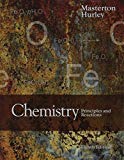
Concept explainers
(a)
Interpretation:
The given incomplete reaction needs to be completed.
Concept introduction:
The group-17 of the periodic table is also called as halogens. They are most reactive and most electronegative non-metals in the periodic table. The reactivity and electronegativity of elements decreases down in the group therefore fluorine is most reactive halogen and iodine is least reactive halogen. In other words; in displacement reactions, a more reactive halogen can displace a less reactive halogen to form product. For example, chlorine can displace bromine from its solution but vice-versa is not possible. The reactivity order for halogens is:
(b)
Interpretation:
The given incomplete reaction needs to be completed.
Concept introduction:
The group-17 of the periodic table is also called as halogens. They are most reactive and most electronegative non-metals in the periodic table. The reactivity and electronegativity of elements decreases down in the group therefore fluorine is most reactive halogen and iodine is least reactive halogen. In other words; in displacement reactions, a more reactive halogen can displace a less reactive halogen to form product. For example, chlorine can displace bromine from its solution but vice-versa is not possible. The reactivity order for halogens is:
(c)
Interpretation:
The given incomplete reaction needs to be completed.
Concept introduction:
The group-17 of the periodic table is also called as halogens. They are most reactive and most electronegative non-metals in the periodic table. The reactivity and electronegativity of elements decreases down in the group therefore fluorine is most reactive halogen and iodine is least reactive halogen. In other words; in displacement reactions, a more reactive halogen can displace a less reactive halogen to form product. For example, chlorine can displace bromine from its solution but vice-versa is not possible. The reactivity order for halogens is:
(d)
Interpretation:
The given incomplete reaction needs to be completed.
Concept introduction:
The group-17 of the periodic table is also called as halogens. They are most reactive and most electronegative non-metals in the periodic table. The reactivity and electronegativity of elements decreases down in the group therefore fluorine is most reactive halogen and iodine is least reactive halogen. In other words; in displacement reactions, a more reactive halogen can displace a less reactive halogen to form product. For example, chlorine can displace bromine from its solution but vice-versa is not possible. The reactivity order for halogens is:
Want to see the full answer?
Check out a sample textbook solution
Chapter 21 Solutions
Bundle: Chemistry: Principles and Reactions, 8th, Loose-Leaf + OWLv2, 1 term (6 months) Printed Access Card
- Calculate the pH and the pOH of each of the following solutions at 25 °C for which the substances ionize completely: (a) 0.000259 M HClO4arrow_forwardWhat is the pH of a 1.0 L buffer made with 0.300 mol of HF (Ka = 6.8 × 10⁻⁴) and 0.200 mol of NaF to which 0.160 mol of NaOH were added?arrow_forwardDetermine if the following salt is neutral, acidic or basic. If acidic or basic, write the appropriate equilibrium equation for the acid or base that exists when the salt is dissolved in aqueous solution. If neutral, simply write only NR. Be sure to include the proper phases for all species within the reaction. NaN₃arrow_forward
- A. Draw the structure of each of the following alcohols. Then draw and name the product you would expect to produce by the oxidation of each. a. 4-Methyl-2-heptanol b. 3,4-Dimethyl-1-pentanol c. 4-Ethyl-2-heptanol d. 5,7-Dichloro-3-heptanolarrow_forwardWhat is the pH of a 1.0 L buffer made with 0.300 mol of HF (Ka = 6.8 × 10⁻⁴) and 0.200 mol of NaF to which 0.160 mol of NaOH were added?arrow_forwardCan I please get help with this.arrow_forward
- Determine if the following salt is neutral, acidic or basic. If acidic or basic, write the appropriate equilibrium equation for the acid or base that exists when the salt is dissolved in aqueous solution. If neutral, simply write only NR. Be sure to include the proper phases for all species within the reaction. N₂H₅ClO₄arrow_forwardPlease help me with identifying these.arrow_forwardCan I please get help with this?arrow_forward
 Chemistry & Chemical ReactivityChemistryISBN:9781133949640Author:John C. Kotz, Paul M. Treichel, John Townsend, David TreichelPublisher:Cengage Learning
Chemistry & Chemical ReactivityChemistryISBN:9781133949640Author:John C. Kotz, Paul M. Treichel, John Townsend, David TreichelPublisher:Cengage Learning Chemistry for Engineering StudentsChemistryISBN:9781285199023Author:Lawrence S. Brown, Tom HolmePublisher:Cengage Learning
Chemistry for Engineering StudentsChemistryISBN:9781285199023Author:Lawrence S. Brown, Tom HolmePublisher:Cengage Learning ChemistryChemistryISBN:9781305957404Author:Steven S. Zumdahl, Susan A. Zumdahl, Donald J. DeCostePublisher:Cengage Learning
ChemistryChemistryISBN:9781305957404Author:Steven S. Zumdahl, Susan A. Zumdahl, Donald J. DeCostePublisher:Cengage Learning Chemistry: An Atoms First ApproachChemistryISBN:9781305079243Author:Steven S. Zumdahl, Susan A. ZumdahlPublisher:Cengage Learning
Chemistry: An Atoms First ApproachChemistryISBN:9781305079243Author:Steven S. Zumdahl, Susan A. ZumdahlPublisher:Cengage Learning
 Chemistry: The Molecular ScienceChemistryISBN:9781285199047Author:John W. Moore, Conrad L. StanitskiPublisher:Cengage Learning
Chemistry: The Molecular ScienceChemistryISBN:9781285199047Author:John W. Moore, Conrad L. StanitskiPublisher:Cengage Learning





